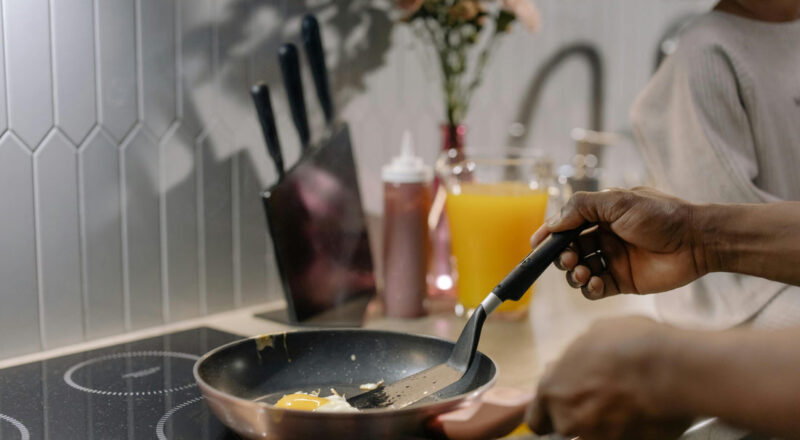If you have ever tried frying eggs in cast iron on induction, you know it can be a delightful experience when done correctly. The combination of a cast iron skillet and an induction cooktop offers a unique cooking method that can enhance the flavor and texture of your eggs. In this article, we will explore how to make the most of this cooking technique, ensuring perfect eggs every time.
Using a cast iron skillet on an induction cooktop is a popular choice among kitchen professionals and home cooks alike. This method provides even heating and precise temperature control, essential for cooking delicate foods like eggs. Let’s dive into the details of how to achieve the best results.

Why Choose Cast Iron for Induction Cooking?
Cast iron has been a staple in kitchens for centuries. Its durability and ability to retain heat make it ideal for various cooking methods. When paired with an induction cooktop, cast iron provides consistent and efficient heat distribution. This combination is perfect for frying eggs, as it allows for precise temperature control and even cooking.
Benefits of Using Cast Iron
- Heat Retention: Cast iron maintains a consistent temperature, reducing the likelihood of hot spots.
- Versatility: Suitable for various cooking techniques, including frying, baking, and roasting.
- Durability: With proper care, cast iron pans can last a lifetime.
Advantages of Induction Cooking
- Energy Efficiency: Induction cooktops use electromagnetic energy, which directly heats the cookware, minimizing heat loss.
- Precision: Allows for precise temperature control, essential for delicate foods like eggs.
- Safety: The cooktop remains cool to the touch, reducing the risk of burns.
Preparing Your Cast Iron Skillet
Before frying eggs, it’s crucial to prepare your cast iron skillet properly. A well-seasoned skillet is essential for preventing sticking and achieving the perfect egg texture.
Seasoning Your Skillet
Seasoning involves coating the skillet with a thin layer of oil and heating it to create a non-stick surface. Here’s how to do it:
- Clean the skillet thoroughly with warm water and a brush.
- Dry it completely using a towel or by placing it on a low heat burner.
- Apply a thin layer of vegetable oil or shortening across the entire surface.
- Heat the skillet in the oven at 375F (190C) for an hour.
- Allow it to cool completely before using.
Choosing the Right Oil
When frying eggs, selecting the right oil is crucial. Oils with high smoke points, such as canola, grapeseed, or avocado oil, are ideal for this purpose. They prevent the eggs from sticking and provide a neutral flavor.
Induction Cooking Techniques for Perfect Eggs
To achieve the perfect fried egg using a cast iron skillet on an induction cooktop, follow these steps:
Preheating the Skillet
Preheating is essential for even cooking. Set your induction cooktop to medium heat and allow the cast iron skillet to heat up for about 5 minutes. This ensures the entire surface is uniformly heated.
Cooking the Eggs
Once the skillet is preheated, add a small amount of oil and let it heat for a few seconds. Crack the eggs into the skillet, ensuring they are evenly spaced. Cook for 2-3 minutes until the whites are set, then cover with a lid for an additional minute to cook the yolk to your desired consistency.
Troubleshooting Common Issues
Even with the best techniques, you may encounter issues while frying eggs in cast iron on induction. Here are some common problems and solutions:
Eggs Sticking to the Skillet
Solution: Ensure the skillet is well-seasoned and preheated before adding the eggs. Also, use sufficient oil to prevent sticking.
Uneven Cooking
Solution: Confirm the skillet is evenly preheated. Induction cooktops provide precise control, so adjust the temperature if you notice uneven cooking.
Additional Tips for Success
To master the art of frying eggs in cast iron on induction, consider these additional tips:
- Use fresh eggs for the best flavor and texture.
- Experiment with different oils to find your preferred taste.
- Consider adding herbs or spices for extra flavor.
Exploring Further Resources
For more insights into using cast iron with induction cooktops, visit this guide on induction heat and cast iron. Additionally, learn about the pros and cons of induction cooktops to enhance your cooking experience.

FAQs
Can I use any cast iron skillet on an induction cooktop?
Yes, most cast iron skillets are compatible with induction cooktops. Ensure the skillet has a flat base for optimal contact with the cooktop surface.
What temperature should I use for frying eggs?
For best results, use medium heat on your induction cooktop. This prevents the eggs from cooking too quickly and ensures even cooking.
How do I clean a cast iron skillet after frying eggs?
After cooking, allow the skillet to cool slightly, then clean with warm water and a soft brush. Avoid using soap, and dry thoroughly before storing. For more cleaning tips, check out this cleaning guide.
This article contains affiliate links. We may earn a commission at no extra cost to you.

